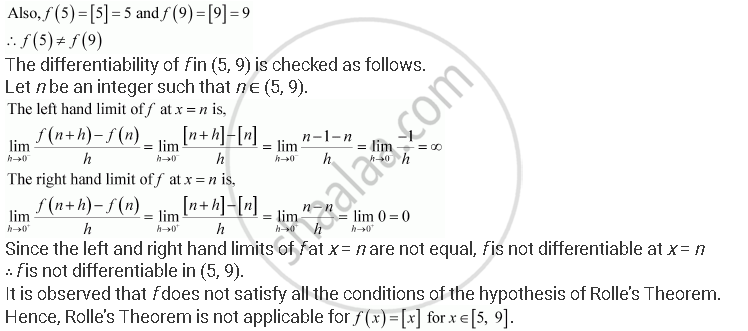Advertisements
Advertisements
प्रश्न
Examine if Rolle’s Theorem is applicable to any of the following functions. Can you say some thing about the converse of Rolle’s Theorem from these examples?
f (x) = [x] for x ∈ [5, 9]
उत्तर
By Rolle’s Theorem, for a function f: [a, b] → R, if
(a) f is continuous on [a, b]
(b) f is differentiable on (a, b)
(c) f (a) = f (b)
then, there exists some c ∈ (a, b) such that f'(c) = 0
Therefore, Rolle’s Theorem is not applicable to those functions that do not satisfy any of the three conditions of the hypothesis.
f (x) = [x] for x ∈ [5, 9]
It is evident that the given function f (x) is not continuous at every integral point.
In particular, f(x) is not continuous at x = 5 and x = 9
⇒ f (x) is not continuous in [5, 9].

APPEARS IN
संबंधित प्रश्न
Check whether the conditions of Rolle’s theorem are satisfied by the function
f (x) = (x - 1) (x - 2) (x - 3), x ∈ [1, 3]
Verify Rolle’s theorem for the function f (x) = x2 + 2x – 8, x ∈ [– 4, 2].
Examine if Rolle’s Theorem is applicable to any of the following functions. Can you say some thing about the converse of Rolle’s Theorem from these examples?
f (x) = [x] for x ∈ [– 2, 2]
If f : [– 5, 5] → R is a differentiable function and if f ′(x) does not vanish anywhere, then prove that f (– 5) ≠ f (5).
Verify Mean Value Theorem, if f (x) = x2 – 4x – 3 in the interval [a, b], where a = 1 and b = 4.
Verify Mean Value Theorem, if f (x) = x3 – 5x2 – 3x in the interval [a, b], where a = 1 and b = 3. Find all c ∈ (1, 3) for which f ′(c) = 0.
Verify Lagrange's Mean Value Theorem for the following function:
`f(x ) = 2 sin x + sin 2x " on " [0, pi]`
Verify Langrange’s mean value theorem for the function:
f(x) = x (1 – log x) and find the value of c in the interval [1, 2].
Verify Rolle’s Theorem for the function f(x) = ex (sin x – cos x) on `[ (π)/(4), (5π)/(4)]`.
Verify Mean value theorem for the function f(x) = 2sin x + sin 2x on [0, π].
Verify Rolle’s theorem for the function, f(x) = sin 2x in `[0, pi/2]`.
Verify mean value theorem for the function f(x) = (x – 3)(x – 6)(x – 9) in [3, 5].
The value of c in Rolle’s Theorem for the function f(x) = e x sinx, x ∈ π [0, π] is ______.
f(x) = `x(x + 3)e^((–x)/2)` in [–3, 0]
f(x) = `sqrt(4 - x^2)` in [– 2, 2]
Discuss the applicability of Rolle’s theorem on the function given by f(x) = `{{:(x^2 + 1",", "if" 0 ≤ x ≤ 1),(3 - x",", "if" 1 ≤ x ≤ 2):}`
Find the points on the curve y = (cosx – 1) in [0, 2π], where the tangent is parallel to x-axis
Using Rolle’s theorem, find the point on the curve y = x(x – 4), x ∈ [0, 4], where the tangent is parallel to x-axis
f(x) = `1/(4x - 1)` in [1, 4]
f(x) = x3 – 2x2 – x + 3 in [0, 1]
f(x) = sinx – sin2x in [0, π]
The value of c in Rolle’s theorem for the function f(x) = x3 – 3x in the interval `[0, sqrt(3)]` is ______.
For the function f(x) = `x + 1/x`, x ∈ [1, 3], the value of c for mean value theorem is ______.
Rolle’s theorem is applicable for the function f(x) = |x – 1| in [0, 2].
A value of c for which the Mean value theorem holds for the function f(x) = logex on the interval [1, 3] is ____________.
If A, G, H are arithmetic, geometric and harmonic means between a and b respectively, then A, G, H are
Value of' 'c' of the mean value theorem for the function `f(x) = x(x - 2)`, when a = 0, b = 3/2, is
If `1/(a + ω) + 1/(b + ω) + 1/(c + ω) + 1/(d + ω) = 1/ω`, where a, b, c, d ∈ R and ω is a cube root of unity then `sum 3/(a^2 - a + 1)` is equal to
Rolle's Theorem holds for the function x3 + bx2 + cx, 1 ≤ x ≤ 2 at the point `4/3`, the value of b and c are
`lim_(x→0) sqrt(1 - cosx)/(sqrt(2)x)` is ______.
